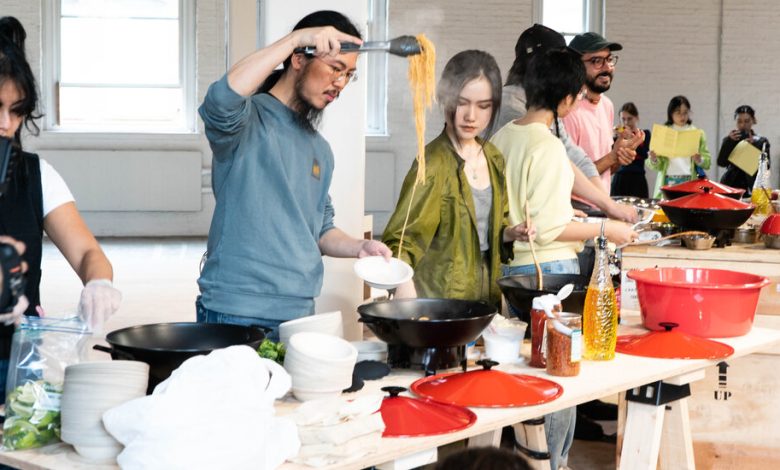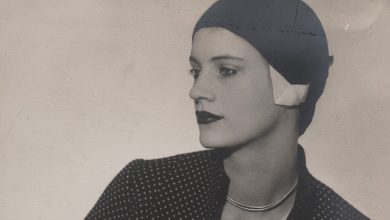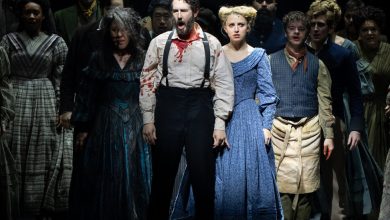Rirkrit Tiravanija: Can Pad Thai Diplomacy Change the World?

“Having been labeled as the cook of the art world,” Rirkrit Tiravanija said, “I think people come to see my work expecting to interact.” Indeed, they expect to eat.
The 62-year-old artist is easily the most influential of the loose cadre that rose to prominence in the early 1990s under the banner of “relational aesthetics” — a kind of installation- and performance-based conceptual work that makes spectators feel like participants. Tiravanija’s “untitled 1990 (pad Thai),” in which he cooked and served noodles in the back room of Paula Allen Gallery, is quintessential.
Tiravanija’s early relational pieces — offering curry and tom ka soup, sodas and beers, grass mats and pillows for weary visitors — appeared as museums increasingly promoted the politics of multiculturalism. The relative unfamiliarity of Thai cuisine in the United States was part of the work’s thrust. Thirty years later, there’s nothing unusual about a soup line at an art museum, and institutions heap adjectives like “interactive,” “immersive” and “inclusive” on their exhibitions like sprinkles on ice cream.
For Tiravanija’s largest survey to date, “A Lot of People,” on view at MoMA PS1 through March 4, the organizers tout the activities. An ad for the show reads: “Play Ping-Pong. Taste curry. Make music.” (It’s unclear why you’d want to do these things in a museum.)
But this menu is a bait-and-switch. Food and fun make up a slim portion of a show characterized by remnants of previous works — from the artist’s fingernail clippings and beard hairs taped inside frames, to videotaped recollections of a road trip across the United States he took with students. The original “pad Thai” lives on as ingredients and scraps from 1990 arranged in a vitrine, sealed in bottles or crusted onto woks.
There’s cooking, of course. On Fridays and Saturdays, a low plywood stage hosts a series of the artist’s participatory works — you can taste curry from Dec. 15 to Jan. 6, and beer and soda from Jan. 12 to Feb. 3. The stage underlines that Tiravanija (pronounced tee-RAH-vah-nit) has recast these works, somewhat elegiacally, as “plays,” acted out by people who aren’t him. (At PS1, it’s mostly his students from Columbia.) The artist said he wanted “a framing device” around these early performances, “to say to viewers that you’re not actually looking at the real thing.”
The phrase “A Lot of People,” the show’s title, is often included in the artist’s recipe-like lists of materials for his happenings: “Ingredients for pad Thai, utensils, electric woks and a lot of people.” Tiravanija’s true subject is people — demonstrations, democracy, — a-lot-of-people power. And his artwork’s politics, rooted in participation and community, appear mostly the same way: as leftovers from past actions.
In the lobby, a gradually expanding charcoal mural reproduces pictures of demonstrations against book bans, like a man and child adorned with a placard: “Baby’s First Protest.”
Upstairs, hung salon style, are 100 small pencil renderings from Tiravanija’s unruly series of “Demonstration Drawings,” depicting street clashes in Thailand, anti-Iraq War marches and other scenes of global unrest from 2002 to 2007. In the next room, a 2015 work subtitled “bangkok boogie-woogie” consists of bronze casts of tires and a video of one on fire; the wall label calls it a “memorial” to Thai protests bloodily suppressed in 2010.
These aren’t calls to action; they’re pictures of the way that most demonstrations exist, for most people, as pictures. They depict the distance between us and other people. The “Demonstration Drawings,” especially, are charged but chilly. Tiravanija paid Thai draftspeople to sketch his collection of protest photos from around the world from The International Herald Tribune. Then, he told me, he used his share of the works’ sales to finance an experimental community in northern Thailand called the Land— a project that, although art-star friends like Superflexand Philippe Parrenohave been involved, he insists is not an artwork. His most affecting pieces practically scream: There’s more to life than art! From a museum’s perspective, that’s an awkward tagline.
Tiravanija’s aesthetic and political goals are ambivalent and flexible. “Rirkrit is not dogmatic at all,” said Ruba Katrib, who curated the show with Yasmil Raymond. “There’s no prescribed aspect to it. He’s setting up a situation, and people will interpret it or do with it what they will.”
Not least, Tiravanija’s cooking pieces inspired Nicholas Bourriaud, the French curator and writer who defined “relational aesthetics” in a 1998 book. Such convivial settings, he wrote, reasserted the democratic, liberatory principles of the 1960s at a time when basic human encounters had been commodified into gathering “around a duly priced drink.” Over the years, the word “utopian” has peppered descriptions of the artist’s practice: If we could simply come together over a meal, we could reconcile our differences — we could recognize one another’s humanity. …
On the other hand, Claire Bishop, an art historian at the CUNY Graduate Center, countered in a book of her own — “Artificial Hells,” from 2012 — that relational aesthetics is not real democracy but a toothless substitute, since visitors to an art show, in the scheme of things, are on the same political page. The openness of Tiravanija’s work allows the notion that anything could happen; realistically, people stick to social conventions and intellectual ruts.
At PS1, Tiravanija’s work doesn’t catalyze social change. Instead, it reminds us that urgent problems persist outside the institution’s walls, while demonstrating that art is a flimsy way to address them.
Gavin Brown, one of Tiravanija’s earliest supporters and presently director at Gladstone Gallery, which represents the artist in New York, suggested that the work has less to do with “community building” than with egging modernist, Western decorum. “The very fact you are filling the room, the white box, with aromas, and aromas from another culture, I always found particularly confrontational,” he said. Brown has also emphasized the exquisite discomfort of eating with strangers.
One Friday in late October I headed to MoMA PS1 — as did a lot of people — and lined up for my bowl of pad Thai. The smell of fish sauce and ketchup (a Westernized substitution for tamarind paste) frying in electric woks drifted through the former school’s institutional hallways. In a plywood recording booth, visitors noodled on guitars and drums, while another person ad-libbed toneless lyrics. You could sing about anything, and he was singing about pad Thai.
The show opened on Oct. 13, just days after Hamas attacked Israel. The ensuing war was well underway. It was obvious that, even if people in an art museum generally agreed about politics, this was not the case for the Gaza conflict. And Tiravanija’s situation, open as ever, hosted the war’s political spillover.
Two acquaintances were acting in the “play.” On Oct. 20, they told me, nobody had cooked; they’d gone on strike in solidarity with pro-Palestinian rallies around the world. Was this genuine antagonism, of the sort found in healthy public forums? Subsequent interviews with several of the participants painted a muted picture. Representatives of MoMA PS1 had quickly circumscribed the action — the cooks were free to strike but couldn’t solicit signatures on a petition. A green checked kaffiyeh draped on the table was removed by a museum employee. The strikers weren’t paid that day; visitors weren’t fed, and there was nothing to explain why.
When Tiravanija teaches students how to make pad Thai, he told me, it’s not to demonstrate his virtuosity but to impart “some kind of skill outside of making art.” In a milieu rampant with chef-driven experiences, that humble word — “cook” — tempers expectations. The inadequacy that characterizes “A Lot of People” isn’t the work failing (how could it? on what terms?) but the sunk hopes viewers bring with them. It’s as if we seek connections — encounters with the other, for example, or political debate — in art and institutions like PS1 that were never meant to supply them.
Tiravanija said it well: You’re not actually looking at the real thing.
Rirkrit Tiravanija: A Lot of People
Through March 4 at MoMA PS1, 22-25 Jackson Avenue, Long Island City, Queens; 718-784-2084, moma.org.





